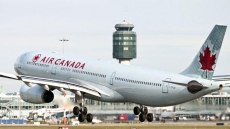KAMLOOPS, B.C. — Smoke from wildfires burning in Washington state has caused visibility and air quality problems in British Columbia, but it's also helping to keep the province's own fires in check.
A thick haze blanketing many communities in southern B.C. is acting like cloud cover and calming fires, said fire information officer Kevin Skrepnek.
"It is actually absorbing some of the heat that would be reaching the ground, and it's keeping some of that humidity trapped," he said Monday.
Skrepnek said 10 new fires were discovered on the weekend, a marked decrease from some days in July and early August when dozens were found in a single day.
While the number of new fires may be going down, but Skrepnek said it's too early to say it's the end of fire season.
The province has spent $233 million fighting 1,753 fires so far this year.
Currently, there are about 180 fires burning across the province, including a 45-square-kilometre blaze west of Rock Creek that claimed 30 homes earlier this month. The fire is now about 75 per cent contained.
The Stickpin fire also continues to rage in Washington state, about 4.5 kilometres south of the border.
British Columbia crews are helping their American counterparts fight the 192-square kilometre blaze Sunday.

Thirty three fire personnel, three officers and two pieces of heavy machinery are now responsible for the northern side of the fire bordering Canada.
Firefighting aircraft could also be sent south as well, Skrepnek said.
Smoke from several Washington fires has limited visibility and prompted air quality warnings across southern B.C.
Environment Canada issued air quality alerts for parts of the region Sunday because of the high levels of fine particulate matter in the air and cautioned people to avoid strenuous activity outdoors.
Metro Vancouver also issued an air-quality advisory for central and eastern Fraser Valley.
Dr. Kamran Golmohammadi, medical health officer for Interior Health, said tiny particles can lodge deep in people's lungs, causing respiratory problems.
Young children, older adults, pregnant women and people with pre-existing heart and lung conditions are at highest risk, he said, adding symptoms include eye irritation, chest tightness and runny noses.
Smoke is expected to lift over many regions Tuesday, though it is expected to stick around the Kootenays for a few more days.




